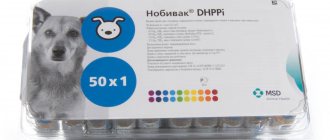Where is it better: at home or at the vet?
Of course, if you have the necessary skills to set up a thermometer, you have the necessary tools and your pet is accustomed to calm behavior when performing medical procedures, this procedure is quite feasible at home.
If you are unsure about any of these points, we advise you to contact your veterinarians.
A professional approach will allow you to measure the temperature quickly and correctly, avoiding injury to your pet due to negligence.
What will you need to measure at home?
To do this, purchase a regular medical thermometer at the pharmacy. Both mercury and electronic are suitable. The second option is preferable due to the safety of the device and faster measurement, which makes the manipulation more convenient for both you and the dog.
Advice!
For reasons of hygiene, it is not recommended to use this device by family members or measure the temperature of other animals.
Since the temperature in dogs is measured rectally, take care of the composition with which you lubricate the tip of the thermometer. A light water-based cream, Vaseline or oil are suitable for these purposes - they will make the procedure painless.
We recommend reading: Should you neuter your dog? All the pros and cons.
How to measure a dog's temperature at home
Before measuring a dog’s temperature at home, the owner must make sure that he has a suitable thermometer (preferably an electronic one), that he is confident in his own abilities, and that an assistant is present when carrying out the procedure for the first time.
Now step by step:
- We clarify the norm parameters for your specific breed in advance.
- We calm the dog down, if necessary, give him something to drink, or maybe cheer him up with a treat. The calmer the dog is, the better the indicator will be determined.
- We position the pet's body so that it stands or lies on its side.
- We set up the thermometer according to the instructions. On the electronic one, after turning on, we wait for the English letter L, we knock the mercury below 37°.
- We insert the sensitive tip of the device into the anus and expect a certain result.
- The signal for the end of thermometry for an electronic thermometer will be a buzzer, for a mercury thermometer - the cessation of movement of the mercury filler in the thermometer scale (usually 7-10 minutes is enough for this).
- Clean the devices with a cotton swab containing alcohol, sterillium, vodka, etc.
Important: if the dog is a puppy or small, then be twice as careful - their temperature can be elevated without pathologies for a short period of time.
Can you do it alone or do you need several people?
This depends on the dog’s temperament and whether it is trained to tolerate such actions calmly.
In this regard, it is most difficult with choleric individuals. Even if you have a small pet, you may need an assistant to keep it in a more or less calm state for a couple of minutes. Representatives of large breeds (Alabais, Caucasian Shepherds, etc.) can be difficult to lay on their sides (and it is in this position that it is recommended to insert the thermometer and take measurements).
To be sure that you can handle it alone, we advise you to accustom your pet to similar procedures from puppyhood and correct its behavior.
Important!
Contacting a veterinary clinic does not guarantee that this procedure will take place peacefully and quickly. A visit to the veterinarian is stressful for an animal, so a calm pet at home can become uncontrollable in the clinic.
And the fixation of an animal in many veterinary clinics is either carried out by the owner or with the help of employees, but for a fee. Find out what conditions this service is provided in your clinic.
Average normal values
Each breed has its own standardized temperature parameters. However, veterinarians have identified a certain dependence of this value, based on the characteristics of the breed, the age of the pet and its overall dimensions. The table below shows the temperature ranges that are considered “normal” for various breeds :
| Age and size of the dog | Temperature values (°C/from and to) |
| Young individual: | |
| small breed | 38.5–39.3 |
| medium sized breed | 38.5–39.0 |
| large breed | 38.0–39.0 |
| Adult: | |
| small breed | 38.5–39.0 |
| medium sized breed | 37.5–39.0 |
| large breed | 37.5–38.5 |
The presence of deviations from the norm can be associated not only with the disease of the animal . A standard set of reasons that can affect the temperature of a dog’s body:
- strong physical activity;
- a sharp state of fear;
- labor pains in bitches;
- increase in temperature during estrus in females.
What is better to use: a regular mercury thermometer or an electronic one?
Of course, you can use a mercury thermometer, but it has several disadvantages compared to its electronic counterpart:
- quite long measurement time - 5 minutes;
- not safe due to the presence of mercury;
- fragile, as it is made of thin glass;
- difficult to find in pharmacies;
- There is no elastic tip, as in most electronic models, which is why it is dangerous and requires proper insertion skills.
For objectivity, it is worth noting that an electronic thermometer does not always show correct data (error 0.5-1.0°C), so for accuracy it is recommended to take several measurements.
Remember!
Enterprising traders offer dog owners infrared thermometers, stickers and temperature indicators for these purposes.
Such devices are not used in veterinary medicine and cannot show the actual level of an animal’s body temperature.
What thermometer is used in veterinary clinics?
In specialized institutions you can most often find an electronic thermometer - it is more convenient, as we already found out above. In addition, it is more readily available for sale, and its price is low, so such thermometers are available both in inexpensive city and regional veterinary stations, and in paid clinics.
How to check without a thermometer?
To measure temperature readings without a thermometer, veterinarians advise using 1 of the 4 methods below:
- Touch your pet's paw pads and ears. If some kind of infection has entered the dog’s body and caused a rise in temperature, then you will find hot paws and ears of the animal. This is due to the accumulation of a large number of blood vessels in these areas. When an infection occurs, blood flow to the paws increases.
- Touch the groin or armpit area. As the temperature rises, the groin and armpits become unnaturally hot. In addition, there may be slight swelling in these areas.
- Checking the condition of the gums. In a healthy animal, the gums should always be moist and have a pink tint. If your pet's mouth is dry and pale, we can confidently say that he has a fever. And this is a direct indicator of infection entering the body.
- Prolonged trembling of the limbs of the animal’s body indicates a sharp drop in body temperature. If you feel feverish, immediately measure your dog’s temperature.
Can you tell by the nose?
Many also believe that a characteristic sign of high fever is a hot, dry nose. However, this is largely a misconception, since a dry nose does not directly determine whether a pet is sick or not.
Periodic drying and heating of the tip of the nose may be due to the following reasons:
- excessively active games or physical activity;
- general fatigue of the dog’s body due to a long walk on the street;
- a warm and dry room in the apartment (especially in the winter months);
- after sleep, metabolism is slowed down and moisture secretion is reduced;
- severe nervous tension;
- the dog’s body’s reaction to a sudden change in weather;
- hormonal changes in a pet during estrus or after birth.
The reasons listed above should not be accompanied by potential signs of illness - refusal of food and water, diarrhea, etc. If you observe several similar symptoms at the same time, then it is still worth checking your temperature.
Step-by-step instructions on how to correctly measure a dog's temperature
- Prepare all the tools and calm the animal. To maintain cleanliness, you can wear medical gloves.
- Lubricate the tip of the thermometer to make it easier to insert into your dog's rectum. If you have a mercury thermometer, do not forget to shake it before starting the measurement so that the mercury column takes the normal position on the scale. The electronic one is turned on by pressing a button (usually this is the only button on the device).
- Lay the animal on its side (preferably, but it is also possible in a standing position), and lift the root of the tail with your left hand.
- Gently insert the lubricated tip of the thermometer into the sphincter of the anus. Praise the animal if it takes the procedure calmly.
- Carefully deepen it 1.5-2 cm.
- Wait 3-5 minutes if you are measuring the temperature with a mercury thermometer, or wait for a beep if using a digital one. During the measurement, talk calmly and affectionately to your pet.
- Carefully remove the thermometer from the dog's intestine and praise it for its exemplary behavior during the procedure.
- Remember or write down the result, turn off the thermometer and disinfect it with soapy water.
We recommend reading: How to properly feed your pet natural food?
Peculiarities of measurement in puppies: are there any differences from an adult dog?
The algorithm for measuring a puppy’s body temperature is not much different from that described above. Here you just need to take into account 2 nuances:
- puppies, like all cubs, are more mobile than adult dogs, so combine the manipulation with rewarding the dog with a treat;
- exceeding the norm by up to 1.5 degrees is normal for puppies.
How often should I measure?
The frequency of temperature monitoring depends on the situation. If the goal is to accustom the puppy to this procedure, then it is enough to do this once every 3-7 days.
For preventive purposes (for example, after vaccination or illness), it is recommended to measure your temperature daily.
When the dog is sick, the frequency of measurements should be increased to 3 times a day. It would also be a good idea to keep a table where you will record the measurement results. With the help of such “temperature diaries” you can easily track the effectiveness of treatment and improvement in your pet’s condition.
How to measure?
To carry out the measurement, use a thermometer (mercury gives more accurate readings, but an electronic one shows the result faster). It is administered rectally (into the dog's anus). Here is an algorithm for how to measure a dog’s temperature correctly:
- Calm your pet, lay him on his side, stroke his belly. The dog should relax.
- The tip of the thermometer is lubricated with greasy ointment (baby cream is usually used for this purpose).
- The animal's tail is raised, the thermometer is slowly inserted into the rectum (2-2.5 cm for large individuals, 1-1.5 cm for small ones).
- While the measurement is taking place, talk to your pet, stroke it, and treat it with your favorite treat.
- After completing the measurement (5 minutes for mercury thermometers, 30-40 seconds for electronic ones), carefully remove the thermometer, praise the animal, and write down the data obtained. Wash the thermometer and hands with warm soapy water, and if necessary, disinfect with an alcohol solution.
Thanks to this algorithm, you can easily find out the condition of your pet. Handle the dog carefully and calmly, do not frighten it.
What is considered normal in dogs?
The temperature of a healthy dog is in the range of 37-39°C.
However, these are average data. More accurate ones depend on the individual characteristics of the pet: age, breed, weight. Decorative breeds have the highest body temperature, it can reach 39.3°C. In dogs of large and giant breeds, on the contrary, the normal limit ends at 38.3°.
In puppies, there is usually a deviation from the norm of 0.5°C upward.
In older dogs over 7 years old, thermometer readings ranging from 37 to 39°C will be considered normal.
Also, animals may experience an increase in body temperature during excitement, fear, after physical exertion, in bitches - during estrus, in puppies - during teething.
What to do if the temperature is high or low?
If your dog has a fever (39.5-40°C), provide him with rest, access to clean water, and think about what could be causing the disease.
An increase above 41°C is critical for the animal! The body begins to lose fluid, the heartbeat and breathing increase, the dog is depressed, and most often there is no appetite.
You need to try to bring down the temperature yourself by giving an intramuscular injection of no-shpa, analgin and suprastin in a 1:2:1 ratio. In any case, be sure to show your pet to a veterinarian.
Attention!
The consequences of untimely contacting a veterinarian and ignoring the serious condition of the dog can be cerebral edema and the death of your pet!
For hypothermia, emergency measures include moving to a warm room and warming the animal. If the temperature is very low (less than 34°C), its normalization leads to severe pain; this condition is considered serious and requires urgent assistance from a veterinary specialist.
Fever in a dog
There are a number of reasons that can cause a fever in an animal:
If a pet has experienced severe stress, then its temperature may rise for a short period of time, for example, after moving. Knowing what temperature is considered normal in dogs, the indicators in such a situation will differ by no more than 2°C. When an infection settles in the body, the body begins to fight it, which leads to the appearance of fever. In hot weather, the cause of illness often lies in overheating of the body
In this case, it is useful to know what to do if the dog has a fever, since the condition can be critical. It is necessary to move the pet to a cool place, be sure to provide it with water and gradually cool the body. Various inflammations, tumors and even external injuries can cause fever, so it is important for diagnosis to pay attention to other symptoms and consult a doctor for an examination.
What to give your dog for fever?
If it is not possible to take the animal to the clinic or invite a veterinarian home, then you need to help the pet on your own. There are a number of recommendations on how to lower your dog’s temperature at home.
Take ice cubes, wrap them in cloth and place them on your neck and inner thighs. You can take a wet towel and cover the animal with it. It is not recommended to intentionally wet the fur, as this will disrupt thermoregulation.
It is important to consider that at high temperatures, the pet needs to drink, otherwise dehydration may occur. It is recommended to ventilate the room where the sick dog is. In summer, you can use the air conditioner for cooling. If you know what the dog’s temperature is considered normal, and the value on the thermometer is much higher, then you can give the animal an antipyretic.
The permitted dose is no more than 0.2 tablets, otherwise the pet may be harmed. You can use analgin, nurofen or paracetamol. Puppies should be given baby formula. Please note that the tablet only reduces the temperature, but you can cope with the cause of the malaise. Contact your veterinarian.
How to determine without a thermometer?
There is still a misconception among dog breeders that a hot nose is a sign of an unhealthy pet.
In fact, this organ's main function is the sense of smell, and a cold and damp nose is much more sensitive to odors. By the way, this is why dogs often lick, because they mainly navigate the world around them by smell, and it is necessary to maintain the “working tool” in excellent condition.
During sleep, the animal relies on hearing and does not use the sense of smell, so the nose of a sleeping pet has the right to be dry and hot.
And for a dog who is hot, it will be wet and hot. Therefore, we reject the option of determining the dog’s temperature by feeling its nose.
If you want to find out by touch whether your pet’s temperature is elevated, touch the paws and ears with the back of your hand - if the dog has a fever, they will be noticeably hot.
A decrease in body temperature can be determined by breathing - the animal begins to breathe rarely and shallowly. Also, with hypothermia, the skin becomes lighter, the paws tremble, and the pupils may be dilated.
We recommend reading: Pancreatitis in dogs: symptoms, treatment and prevention
This is fine
All dogs have different body temperatures. This is influenced by metabolic processes and heart rate.
We determine your pet's temperature without a thermometer.
To correctly determine without a thermometer that your pet has a temperature, you need to know the right places that will help determine.
Nose. If you previously read information about dry nose being a dog disease, this is not true. When your dog just gets a dry nose or after a trip to the vet, this is a lot of stress for your pet. You should be very concerned if your dog has a dry, hot, and sometimes cold nose for a very long time. It’s even worse if there is discharge from it.
Gums. While it is still possible to make a mistake when determining the temperature from the nose, the gums give a clearer answer. If the dog is sick and has a fever, the gums will be red, dry, sometimes with sores. When you touch a dog’s gums, they should be the same temperature as your finger; if they are hot, measure the temperature. Examine the ears and paws; if they are hot, then your dog is in the process of becoming ill.











